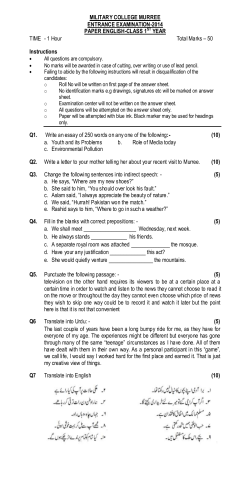
LnSCM_revision_with answers_6pp
Agenda Topic Revision Exam Practice Questions Common Mistakes/tips EBU5609 Logistics and Supply Chain Management Revision 2 Note: Exercises for this session are not necessarily those in the exam Revise all areas as you can! Revise case studies Have a ‘bank’ of examples Topics Covered 3 1 Introduction to Logistics and Supply Chain Management 2 Supply Chain Organisation 3 Process Thinking: SCM's Foundation 4 Technology in Logistics and Supply Chain 5 Customer Fulfilment 6 Order Fulfilment Cycle - Purchasing, Production and Logistics 7 Supply Chain Mapping 8 Core Competencies and Outsourcing 9 Environmental Scanning and Global Supply Chain 10 Cost Management in SCM 11 Inventory Management 12 Managing Uncertainty in the Supply Chain 13 Operational issues in the Supply Chain 14 Performance Measurement in the Supply Chain 15 Collaborative Innovation in the Supply Chain 16 Law and Ethics in SCM 17 People Management 18 Relationship Management Exam Practice Questions 5 EBU5609 4 6 1 Exam format – NEW! Exam format – NEW! The exam lasts for 2 hours You have to answer ALL FOUR questions They are all compulsory questions Each question carries a maximum of 25 marks You can be asked about anything that was covered during the module There are no complex calculations or multiple choice questions Some questions are using the structure below: Q1: Total marks – 25 marks Part A: Define/concepts (5 marks) Part B: Describe/examples (5 marks) Part C: Discuss/essay-type questions (15 marks) EBU6606 - revision EBU6606 - revision 7 8 Exam format – NEW! Question 1: In the exam you have to answer ALL FOUR questions in 2 hours These practice questions are only 15 marks each. So please finish writing the key points of your answers in 5 minutes each. We will go through the questions when you have finished each one of them. Compare bar codes and RFID and give some examples of situations where you believe that RFID has advantages compared with bar codes. [15 marks] Your time starts now Possible answers EBU5609 2 Sample Answers Sample Answers (cont’d) 6 marks awarded as follows: • 3 marks for the definition of RFID • 3 marks for the definition/description of barcode 9 marks for the circumstances where RFID is better than barcode (see next slide) • RFID is used extensively in warehouse and distribution centre operations (2 marks) • RFID improves picking efficiency and accuracy (2 marks) • Other benefits include: time-saving; (1 mark) easy to track; (1 mark) large volume of information gathered at the same time; (1 mark) But barcodes are still in use, especially at POS (point of sales) level, due to its low-cost and compatibility with existing information systems. (2 marks) 13 Question 2: 14 Your time starts now Consider a manufacturer of wooden toys. Discuss how it could gain from inventory management so as to enhance efficiency? [15 marks] Possible answers Sample Answers 15 marks awarded as follows: • 5 marks if ‘seasonal product’ is mentioned and corresponding inventory management methods discussed. • 5 marks for focussing on ‘wooden’, implying classic designs, where the issue of ‘obsolesce’ is not an immediate concern. • 5 marks for focussing on ‘toys’, implying price-sensitive consumer goods with lots of competition, where ‘efficiency’ is prioritised when considering transportation mode, in the pair of trade-offs of ‘efficiency vs. responsiveness’. EBU5609 18 3 Tips: Exam Skills and Common Mistakes Tips: Take time at the beginning to read the question carefully If you do not know the answer, do not write about other topic as your answer; you will not get the marks. Instead look at a different question, how much can you answer that question instead? Revise! Revise all lecture notes, further reading, etc. Core text Understand the layout Practice timing yourselves. How long do 4 questions take to answer – allow enough time for all 4, and review time as well. Common Mistakes Where examples were specifically asked for they were not given as part of the student’s answer If a question asks for examples, this means that a significant number of the marks have been allocated for examples If you do not give examples, you will not get those marks Some of the examples that were given were completely irrelevant - so marks were not awarded for them Common Mistakes Many students wrote very little For example, we would expect to see between 2 pages of answers for each question. Many answer books only had ¼ or ½ of a page written for each question It is impossible to receive significant marks, and certainly not 25 marks, when so little is written Practice writing the amount you need for each question Look at how much time you have (i.e. divide 2 hours by 4 and also allow some time for reading the questions at the beginning and checking your answers at the end) EBU5609 with your exams 4
© Copyright 2026









